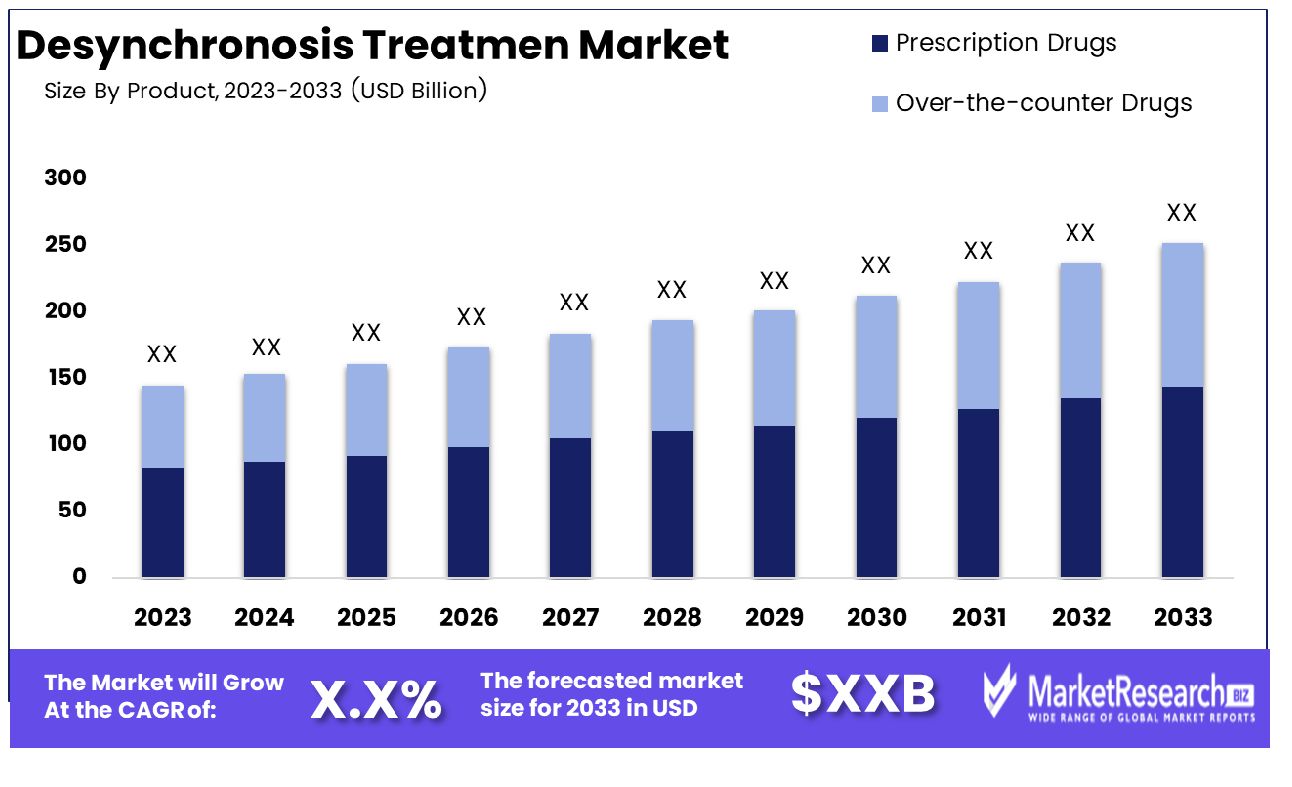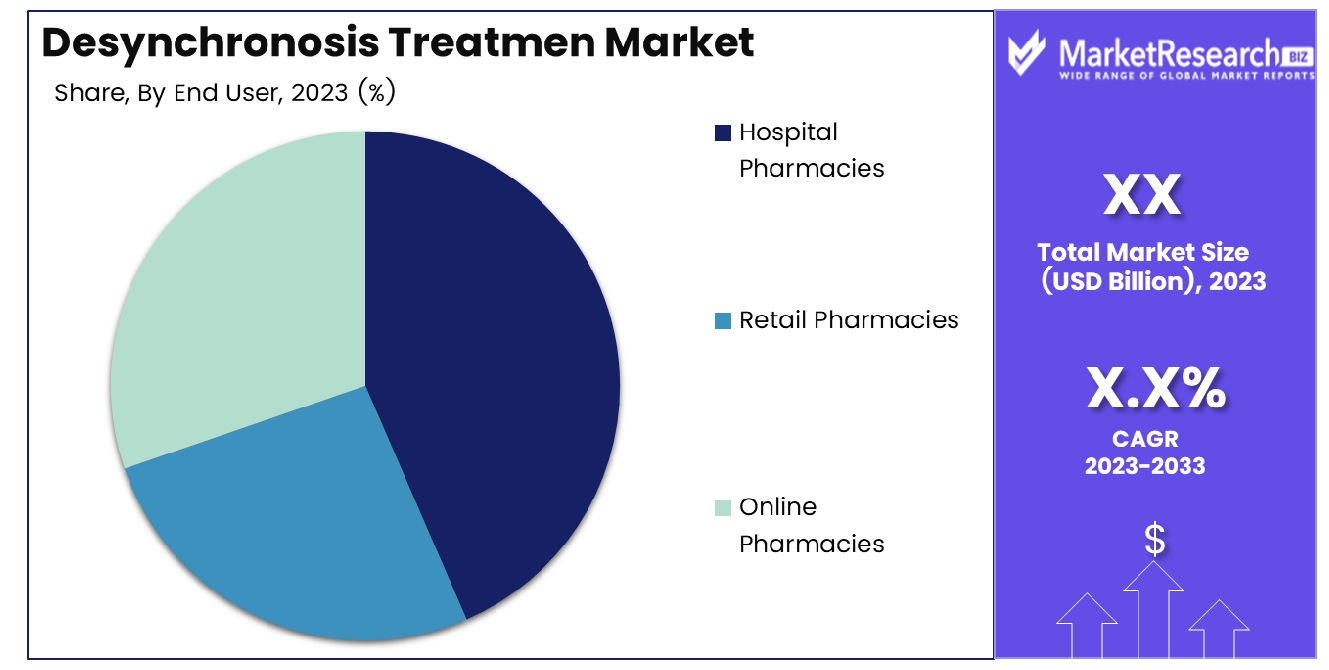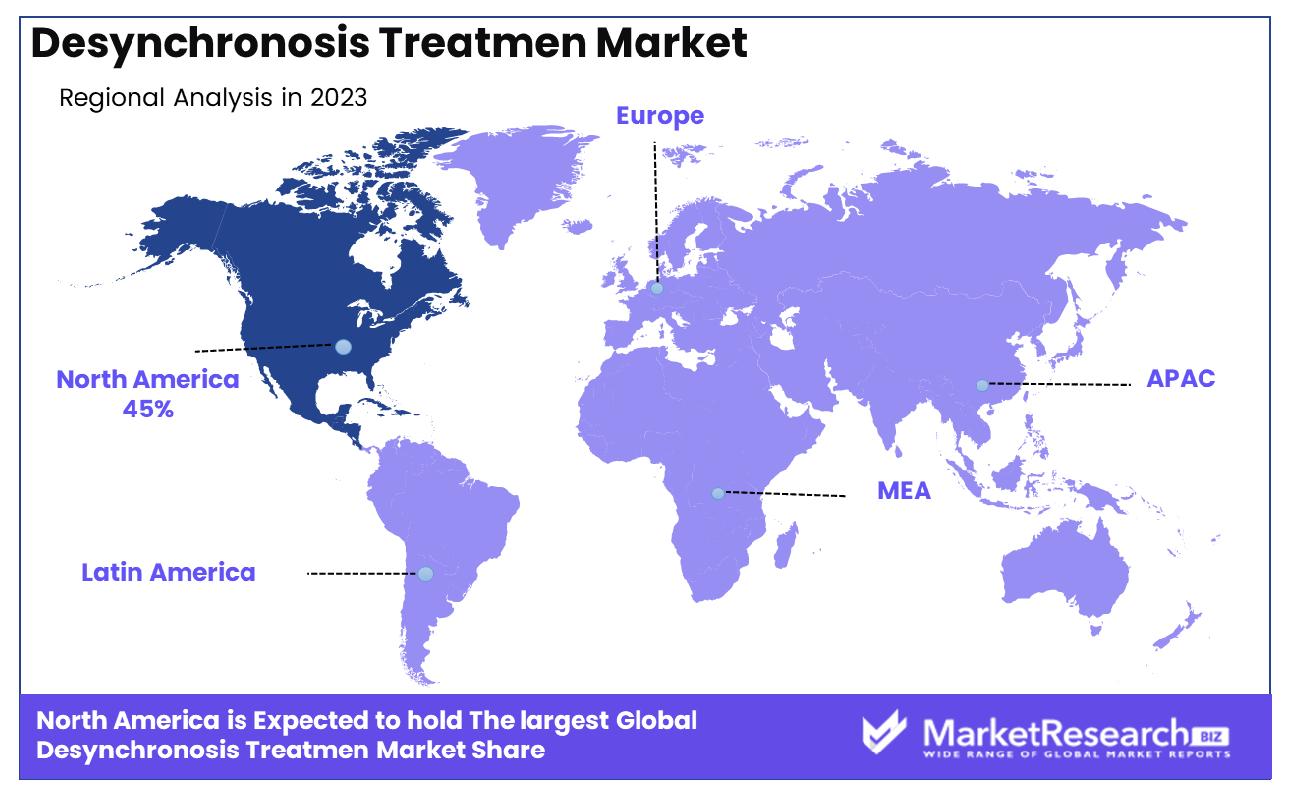
Desynchronosis Treatment Market By Product (Prescription Drugs, Over-the-counter Drugs), By Distribution Channel (Hospital Pharmacies, Retail Pharmacies, Online Pharmacies), By Region and Companies - Industry Segment Outlook, Market Assessment, Competition Scenario, Trends and Forecast 2024-2033
-
47100
-
June 2024
-
136
-
-
This report was compiled by Trishita Deb Trishita Deb is an experienced market research and consulting professional with over 7 years of expertise across healthcare, consumer goods, and materials, contributing to over 400 healthcare-related reports. Correspondence Team Lead- Healthcare Linkedin | Detailed Market research Methodology Our methodology involves a mix of primary research, including interviews with leading mental health experts, and secondary research from reputable medical journals and databases. View Detailed Methodology Page
-
Quick Navigation
Report Overview
The Global Desynchronosis Treatment Market was valued at USD XX Bn in 2023. It is expected to reach USD XX Bn by 2033, with a CAGR of X.X% during the forecast period from 2024 to 2033.
The Desynchronosis Treatment Market encompasses the global landscape of products and services dedicated to addressing desynchronosis, commonly known as jet lag. This market segment revolves around innovative pharmaceuticals, therapies, and digital solutions designed to alleviate the disruptive effects of circadian rhythm misalignment experienced by travelers and shift workers alike. As a critical facet of the healthcare industry, this market reflects a synergy of medical advancements, consumer preferences, and technological innovation aimed at enhancing well-being and productivity. With a growing emphasis on holistic approaches to health and wellness, stakeholders within the Desynchronosis Treatment Market continuously strive to meet evolving demands and exceed expectations.

The Desynchronosis Treatment Market is witnessing a surge in demand and innovation, fueled by a growing awareness of the impact of circadian rhythm disruptions on health and well-being. With stable circadian rhythms being crucial for the expression of key clock genes such as Bmal1, Per2, Cry1, and metabolic genes like Glut4 and leptin, the market is increasingly focusing on solutions that target these biological mechanisms. This is underscored by a pivotal 2002 study revealing a higher incidence of relapse in bipolar and psychotic disorders among individuals crossing multiple time zones within a week.
These findings not only underscore the significance of addressing desynchronosis but also highlight the potential implications for broader health outcomes. From pharmaceutical interventions to digital therapeutics and lifestyle modifications, stakeholders are harnessing a multifaceted approach to meet the diverse needs of consumers and patients.
As the market matures, collaboration between pharmaceutical companies, healthcare providers, and technology firms becomes paramount. This synergy enables the development of comprehensive solutions that not only mitigate the immediate symptoms of jet lag but also promote long-term circadian health and resilience. Moreover, the integration of data analytics and personalized medicine empowers stakeholders to tailor interventions to individual needs, driving both efficacy and patient satisfaction.
Key Takeaways
- Market Value: The Global Desynchronosis Treatment Market was valued at USD XX Bn in 2023. It is expected to reach USD XX Bn by 2033, with a CAGR of X.X% during the forecast period from 2024 to 2033.
- By Product: The Desynchronosis Treatment Market was led by Prescription Drugs, which accounted for 57.4% of the market share by product.
- By Distribution Channel: Hospital Pharmacies dominated, capturing 45.2% of the Desynchronosis Treatment Market.
- Regional Dominance: North America held the dominant position, contributing a significant portion 38% of the global market share.
- Growth Opportunity: The Desynchronosis Treatment Market presents a growth opportunity through targeted research and development to create novel therapies addressing the specific needs.
Driving factors
Growing Mental Health Awareness
The rising awareness and destigmatization of mental health issues have significantly contributed to the growth of the desynchronosis treatment market. As more individuals and healthcare professionals acknowledge the importance of mental health, the focus on conditions like desynchronosis, or jet lag, has intensified. This increased awareness has led to a higher demand for effective treatment options, as people are more likely to seek help when experiencing sleep-related issues.
Statistics indicate that mental health awareness campaigns and initiatives have led to a substantial increase in the number of people seeking mental health services.This trend translates into a greater demand for treatments targeting conditions like desynchronosis, thereby driving market growth.
Advancements in Treatment Options
Advancements in treatment options are another crucial factor propelling the growth of the desynchronosis treatment market. The development of new and improved therapies has expanded the range of available treatment modalities, making them more effective and accessible.
The introduction of new medications that can better manage the symptoms of desynchronosis. For example, melatonin and other sleep aids have become more refined and widely prescribed. The advent of wearable technology and light therapy devices designed to reset the body's circadian rhythm more efficiently. These devices are gaining popularity due to their convenience and efficacy. Enhanced cognitive-behavioral therapy techniques tailored to individuals suffering from sleep disorders, providing non-pharmacological options for patients. The combined effect of these advancements ensures that patients have access to a variety of effective treatments, thereby increasing the overall market demand.
Restraining Factors
Economic Barriers to Accessing Treatment
One of the primary restraining factors for the growth of the desynchronosis treatment market is the high cost associated with effective treatment options. Advanced treatments, including specialized medications, wearable technology, and personalized behavioral therapies, often come with significant price tags. These costs can be prohibitive for many individuals, limiting the overall market reach.
High treatment costs also affect insurance coverage and reimbursement policies, which can further restrict access. Not all insurance plans cover the full range of treatments for desynchronosis, leading to out-of-pocket expenses that many cannot afford. For instance, a comprehensive treatment plan involving multiple therapeutic approaches might cost several thousand dollars annually, making it inaccessible for a significant portion of the population.
Lack of Standardized Protocols
The lack of standardized protocols for diagnosing and treating desynchronosis presents another significant barrier to market growth. Currently, treatment approaches can vary widely between practitioners and regions, leading to inconsistent patient outcomes. This variability makes it challenging to establish widely accepted best practices and protocols, which are crucial for widespread adoption and trust in the treatments.
The absence of standardized protocols also complicates clinical trials and regulatory approvals, slowing the introduction of new treatments into the market. Without a clear, standardized approach, it is difficult to measure the efficacy of new therapies consistently, which can delay their acceptance and implementation.
By Product Analysis
Prescription Drugs dominated the By Product segment of the Desynchronosis Treatment Market with a 57.4% share.
In 2023, Prescription Drugs held a dominant market position in the By Product segment of the Desynchronosis Treatment Market, capturing more than a 57.4% share. This significant market share is attributed to the effectiveness and tailored nature of prescription medications, which are often recommended by healthcare professionals for the precise management of desynchronosis symptoms. Prescription drugs typically offer a more targeted approach to treatment, leading to better patient outcomes and higher adherence rates.
Over-the-counter (OTC) Drugs also played a crucial role in the Desynchronosis Treatment Market in 2023. While they did not surpass the market dominance of prescription drugs, OTC drugs offered a convenient and accessible option for many individuals suffering from desynchronosis. These drugs are preferred for their ease of access, affordability, and the absence of a need for a doctor's prescription. OTC drugs cater to a segment of the market that seeks quick and straightforward solutions to manage mild symptoms of desynchronosis, contributing significantly to the overall market dynamics.
By Distribution Channel Analysis
Hospital Pharmacies led the By Distribution Channel segment, capturing over 45.2% of the market.
In 2023, Hospital Pharmacies held a dominant market position in the By Distribution Channel segment of the Desynchronosis Treatment Market, capturing more than a 45.2% share. This substantial market share can be attributed to the high level of trust and reliability associated with hospital pharmacies. These pharmacies are typically integrated within healthcare facilities, ensuring immediate access to medications post-diagnosis. Additionally, the availability of professional guidance from healthcare providers in hospital settings enhances patient confidence and compliance with prescribed treatments, leading to better management of desynchronosis.
Retail Pharmacies also made a significant impact on the Desynchronosis Treatment Market in 2023. These pharmacies offer widespread accessibility and convenience, catering to a broad demographic. Retail pharmacies are a preferred choice for many patients due to their extended operating hours, proximity to residential areas, and the availability of a wide range of medications. Their role in the market is vital, particularly for those seeking both prescription and over-the-counter treatments for desynchronosis.
Online Pharmacies have been gaining traction and steadily increasing their share in the Desynchronosis Treatment Market. In 2023, they provided a valuable alternative distribution channel, especially appealing to tech-savvy consumers and those preferring the convenience of home delivery. Online pharmacies offer competitive pricing, ease of ordering, and the privacy of purchasing medications from home. This distribution channel is particularly beneficial for chronic sufferers of desynchronosis who require regular and predictable access to their treatments.

Key Market Segments
By Product
- Prescription Drugs
- Over-the-counter Drugs
By Distribution Channel
- Hospital Pharmacies
- Retail Pharmacies
- Online Pharmacies
Growth Opportunity
Adoption of Digital Health Solutions
The integration of digital health solutions presents a transformative opportunity for the desynchronosis treatment market. The proliferation of smartphones, wearable devices, and health tracking apps has empowered individuals to monitor and manage their health more effectively. For desynchronosis patients, digital solutions offer personalized insights into sleep patterns, circadian rhythms, and treatment adherence, enhancing overall therapeutic outcomes. Moreover, telemedicine platforms facilitate remote consultations with sleep specialists, expanding access to care beyond traditional healthcare settings.
Expansion of Treatment Options
The continuous expansion of treatment options is another catalyst driving growth in the desynchronosis treatment market. Innovations in pharmacological, technological, and behavioral therapies are broadening the therapeutic arsenal, catering to diverse patient needs and preferences. Advanced medications, wearable light therapy devices, and tailored cognitive-behavioral interventions offer tailored solutions for managing desynchronosis symptoms effectively. This expansion not only addresses unmet patient needs but also stimulates market demand, creating lucrative opportunities for stakeholders across the value chain.
Latest Trends
Personalized Medicine
One of the prominent trends shaping the desynchronosis treatment market in 2024 is the shift towards personalized medicine. Recognizing that each individual's response to treatment may vary, healthcare providers are increasingly embracing personalized approaches to tailor interventions according to patients' unique characteristics and needs.
Genetic profiling, biomarker analysis, and advanced diagnostic tools enable clinicians to identify specific biological markers associated with desynchronosis susceptibility and response to therapy. By leveraging this personalized approach, healthcare professionals can optimize treatment efficacy, minimize adverse effects, and enhance patient satisfaction.
Employee Well-being Importance
Another significant trend shaping the desynchronosis treatment market in 2024 is the growing recognition of the importance of employee well-being. Employers are increasingly prioritizing the health and wellness of their workforce, recognizing that optimal performance and productivity are closely linked to physical and mental well-being. Desynchronosis, often experienced by individuals with irregular work schedules or frequent travel demands, can significantly impact employee productivity, engagement, and overall quality of life.
Organizations are implementing proactive measures to address desynchronosis and promote better sleep hygiene among employees. Corporate wellness programs, flexible work arrangements, and education initiatives on sleep health are becoming integral components of workplace culture. By investing in employee well-being, organizations not only enhance workforce productivity and retention but also contribute to the growth of the desynchronosis treatment market by fostering demand for effective interventions and solutions.
Regional Analysis
North America holds a dominant position in the desynchronosis treatment market, capturing 38% of the global share.
North America dominates the desynchronosis treatment market, capturing a significant 38% of the global market share. This dominance can be attributed to factors such as the high prevalence of shift work, extensive air travel, and the presence of advanced healthcare infrastructure in the region. According to the Bureau of Labor Statistics, approximately 16% of Americans work non-standard hours, increasing their risk of desynchronosis.
Europe holds a significant share in the desynchronosis treatment market, driven by factors such as the prevalence of shift work, increasing international travel, and growing awareness about sleep disorders in the region. According to Eurostat, approximately 21% of workers in the European Union engage in shift work, increasing their susceptibility to desynchronosis.
The Asia Pacific desynchronosis treatment market is witnessing rapid growth due to factors such as increasing globalization, rising prevalence of shift work, and growing awareness about sleep disorders in the region. According to the International Labour Organization, Asia Pacific has the largest number of workers engaged in shift work globally, increasing the demand for treatments for shift work sleep disorder.
The desynchronosis treatment market in the Middle East & Africa region is experiencing moderate growth, driven by factors such as increasing international travel, rising prevalence of shift work, and improving healthcare infrastructure. According to the International Air Transport Association, the Middle East & Africa region witnessed a steady increase in air passenger traffic in recent years, indicating the potential demand for jet lag treatments.
Latin America represents a growing market for desynchronosis treatment, driven by factors such as increasing international travel, rising prevalence of shift work, and improving healthcare infrastructure in the region. According to the Latin American and Caribbean Air Transport Association, Latin America witnessed a significant increase in international air passenger traffic in recent years, indicating the potential demand for jet lag treatments.

Key Regions and Countries
North America
- US
- Canada
- Mexico
Western Europe
- Germany
- France
- The UK
- Spain
- Italy
- Portugal
- Ireland
- Austria
- Switzerland
- Benelux
- Nordic
- Rest of Western Europe
Eastern Europe
- Russia
- Poland
- The Czech Republic
- Greece
- Rest of Eastern Europe
APAC
- China
- Japan
- South Korea
- India
- Australia & New Zealand
- Indonesia
- Malaysia
- Philippines
- Singapore
- Thailand
- Vietnam
- Rest of APAC
Latin America
- Brazil
- Colombia
- Chile
- Argentina
- Costa Rica
- Rest of Latin America
Middle East & Africa
- Algeria
- Egypt
- Israel
- Kuwait
- Nigeria
- Saudi Arabia
- South Africa
- Turkey
- United Arab Emirates
- Rest of MEA
Key Players Analysis
In 2024, the global Desynchronosis Treatment market is anticipated to witness significant growth, with key players such as Clinigen Group plc, Pfizer Inc, Vanda Pharmaceuticals Inc, NOW Foods, Jamieson Laboratories Ltd, ALEXZA, Purdue Pharma L.P, Nature's Bounty, Eisai Co., Ltd, Jazz Pharmaceuticals, Inc, and other notable participants playing crucial roles in shaping the market landscape. These companies are poised to introduce innovative therapies and address the complex challenges associated with desynchronosis, commonly known as jet lag or shift work disorder.
Clinigen Group plc, with its focus on specialty pharmaceuticals, is expected to contribute significantly to the desynchronosis treatment market. Leveraging its expertise in drug development and distribution, Clinigen aims to offer targeted solutions to alleviate symptoms and improve the quality of life for individuals affected by desynchronosis.
Pfizer Inc, a global leader in the pharmaceutical industry, is also set to play a key role in this market. With a diverse portfolio of products and a strong research and development pipeline, Pfizer is well-positioned to introduce novel therapies for desynchronosis, catering to the needs of travelers and shift workers worldwide.
Vanda Pharmaceuticals Inc, known for its expertise in circadian rhythm disorders, is anticipated to bring innovative treatments to market, addressing the underlying mechanisms of desynchronosis and offering personalized solutions for patients.
Other key players like NOW Foods, Jamieson Laboratories Ltd, and Eisai Co., Ltd are also expected to contribute to the desynchronosis treatment market through the development of complementary therapies and strategic collaborations.
Market Key Players
- Clinigen Group plc
- Pfizer Inc
- Vanda Pharmaceuticals Inc
- NOW Foods
- Jamieson Laboratories Ltd
- ALEXZA
- Purdue Pharma L.P
- Nature's Bounty
- Eisai Co., Ltd
- Jazz Pharmaceuticals, Inc
- Other Key Players
Recent Development
- In April 2024: Philips introduced a compact, wearable light therapy device for desynchronosis, aiding in regulating circadian rhythms and mitigating jet lag symptoms.
- In May 2024: Harvard Medical School unveiled groundbreaking findings on the impact of personalized chronobiology interventions in treating desynchronosis, offering tailored solutions for circadian rhythm disorders.
Report Scope
Report Features Description Market Value (2023) USD XX Bn Forecast Revenue (2033) USD XX Bn CAGR (2024-2033) X.X% Base Year for Estimation 2023 Historic Period 2018-2023 Forecast Period 2024-2033 Report Coverage Revenue Forecast, Market Dynamics, Competitive Landscape, Recent Developments Segments Covered By Product (Prescription Drugs, Over-the-counter Drugs), By Distribution Channel (Hospital Pharmacies, Retail Pharmacies, Online Pharmacies) Regional Analysis North America - The US, Canada, & Mexico; Western Europe - Germany, France, The UK, Spain, Italy, Portugal, Ireland, Austria, Switzerland, Benelux, Nordic, & Rest of Western Europe; Eastern Europe - Russia, Poland, The Czech Republic, Greece, & Rest of Eastern Europe; APAC - China, Japan, South Korea, India, Australia & New Zealand, Indonesia, Malaysia, Philippines, Singapore, Thailand, Vietnam, & Rest of APAC; Latin America - Brazil, Colombia, Chile, Argentina, Costa Rica, & Rest of Latin America; Middle East & Africa - Algeria, Egypt, Israel, Kuwait, Nigeria, Saudi Arabia, South Africa, Turkey, United Arab Emirates, & Rest of MEA Competitive Landscape Clinigen Group plc, Pfizer Inc, Vanda Pharmaceuticals Inc, NOW Foods, Jamieson Laboratories Ltd, ALEXZA, Purdue Pharma L.P, Nature's Bounty, Eisai Co., Ltd, Jazz Pharmaceuticals, Inc, Other Key Players Customization Scope Customization for segments, region/country-level will be provided. Moreover, additional customization can be done based on the requirements. Purchase Options We have three licenses to opt for: Single User License, Multi-User License (Up to 5 Users), Corporate Use License (Unlimited User and Printable PDF) -
- 1. Executive Summary
- 1.1. Definition
- 1.2. Taxonomy
- 1.3. Research Scope
- 1.4. Key Analysis
- 1.5. Key Findings by Major Segments
- 1.6. Top strategies by Major Players
- 2. Global Desynchronosis Treatmen Market Overview
- 2.1. Desynchronosis Treatmen Market Dynamics
- 2.1.1. Drivers
- 2.1.2. Opportunities
- 2.1.3. Restraints
- 2.1.4. Challenges
- 2.2. Macro-economic Factors
- 2.3. Regulatory Framework
- 2.4. Market Investment Feasibility Index
- 2.5. PEST Analysis
- 2.6. PORTER’S Five Force Analysis
- 2.7. Drivers & Restraints Impact Analysis
- 2.8. Industry Chain Analysis
- 2.9. Cost Structure Analysis
- 2.10. Marketing Strategy
- 2.11. Russia-Ukraine War Impact Analysis
- 2.12. Opportunity Map Analysis
- 2.13. Market Competition Scenario Analysis
- 2.14. Product Life Cycle Analysis
- 2.15. Opportunity Orbits
- 2.16. Manufacturer Intensity Map
- 2.17. Major Companies sales by Value & Volume
- 2.1. Desynchronosis Treatmen Market Dynamics
- 3. Global Desynchronosis Treatmen Market Analysis, Opportunity and Forecast, 2016-2032
- 3.1. Global Desynchronosis Treatmen Market Analysis, 2016-2021
- 3.2. Global Desynchronosis Treatmen Market Opportunity and Forecast, 2023-2032
- 3.3. Global Desynchronosis Treatmen Market Analysis, Opportunity and Forecast, By By Product, 2016-2032
- 3.3.1. Global Desynchronosis Treatmen Market Analysis by By Product: Introduction
- 3.3.2. Market Size Absolute $ Opportunity Analysis and Forecast, By By Product, 2016-2032
- 3.3.3. Prescription Drugs
- 3.3.4. Over-the-counter Drugs
- 3.4. Global Desynchronosis Treatmen Market Analysis, Opportunity and Forecast, By By Distribution Channel, 2016-2032
- 3.4.1. Global Desynchronosis Treatmen Market Analysis by By Distribution Channel: Introduction
- 3.4.2. Market Size Absolute $ Opportunity Analysis and Forecast, By By Distribution Channel, 2016-2032
- 3.4.3. Hospital Pharmacies
- 3.4.4. Retail Pharmacies
- 3.4.5. Online Pharmacies
- 4. North America Desynchronosis Treatmen Market Analysis, Opportunity and Forecast, 2016-2032
- 4.1. North America Desynchronosis Treatmen Market Analysis, 2016-2021
- 4.2. North America Desynchronosis Treatmen Market Opportunity and Forecast, 2023-2032
- 4.3. North America Desynchronosis Treatmen Market Analysis, Opportunity and Forecast, By By Product, 2016-2032
- 4.3.1. North America Desynchronosis Treatmen Market Analysis by By Product: Introduction
- 4.3.2. Market Size Absolute $ Opportunity Analysis and Forecast, By By Product, 2016-2032
- 4.3.3. Prescription Drugs
- 4.3.4. Over-the-counter Drugs
- 4.4. North America Desynchronosis Treatmen Market Analysis, Opportunity and Forecast, By By Distribution Channel, 2016-2032
- 4.4.1. North America Desynchronosis Treatmen Market Analysis by By Distribution Channel: Introduction
- 4.4.2. Market Size Absolute $ Opportunity Analysis and Forecast, By By Distribution Channel, 2016-2032
- 4.4.3. Hospital Pharmacies
- 4.4.4. Retail Pharmacies
- 4.4.5. Online Pharmacies
- 4.5. North America Desynchronosis Treatmen Market Analysis, Opportunity and Forecast, By Country , 2016-2032
- 4.5.1. North America Desynchronosis Treatmen Market Analysis by Country : Introduction
- 4.5.2. Market Size Absolute $ Opportunity Analysis and Forecast, Country , 2016-2032
- 4.5.2.1. The US
- 4.5.2.2. Canada
- 4.5.2.3. Mexico
- 5. Western Europe Desynchronosis Treatmen Market Analysis, Opportunity and Forecast, 2016-2032
- 5.1. Western Europe Desynchronosis Treatmen Market Analysis, 2016-2021
- 5.2. Western Europe Desynchronosis Treatmen Market Opportunity and Forecast, 2023-2032
- 5.3. Western Europe Desynchronosis Treatmen Market Analysis, Opportunity and Forecast, By By Product, 2016-2032
- 5.3.1. Western Europe Desynchronosis Treatmen Market Analysis by By Product: Introduction
- 5.3.2. Market Size Absolute $ Opportunity Analysis and Forecast, By By Product, 2016-2032
- 5.3.3. Prescription Drugs
- 5.3.4. Over-the-counter Drugs
- 5.4. Western Europe Desynchronosis Treatmen Market Analysis, Opportunity and Forecast, By By Distribution Channel, 2016-2032
- 5.4.1. Western Europe Desynchronosis Treatmen Market Analysis by By Distribution Channel: Introduction
- 5.4.2. Market Size Absolute $ Opportunity Analysis and Forecast, By By Distribution Channel, 2016-2032
- 5.4.3. Hospital Pharmacies
- 5.4.4. Retail Pharmacies
- 5.4.5. Online Pharmacies
- 5.5. Western Europe Desynchronosis Treatmen Market Analysis, Opportunity and Forecast, By Country , 2016-2032
- 5.5.1. Western Europe Desynchronosis Treatmen Market Analysis by Country : Introduction
- 5.5.2. Market Size Absolute $ Opportunity Analysis and Forecast, Country , 2016-2032
- 5.5.2.1. Germany
- 5.5.2.2. France
- 5.5.2.3. The UK
- 5.5.2.4. Spain
- 5.5.2.5. Italy
- 5.5.2.6. Portugal
- 5.5.2.7. Ireland
- 5.5.2.8. Austria
- 5.5.2.9. Switzerland
- 5.5.2.10. Benelux
- 5.5.2.11. Nordic
- 5.5.2.12. Rest of Western Europe
- 6. Eastern Europe Desynchronosis Treatmen Market Analysis, Opportunity and Forecast, 2016-2032
- 6.1. Eastern Europe Desynchronosis Treatmen Market Analysis, 2016-2021
- 6.2. Eastern Europe Desynchronosis Treatmen Market Opportunity and Forecast, 2023-2032
- 6.3. Eastern Europe Desynchronosis Treatmen Market Analysis, Opportunity and Forecast, By By Product, 2016-2032
- 6.3.1. Eastern Europe Desynchronosis Treatmen Market Analysis by By Product: Introduction
- 6.3.2. Market Size Absolute $ Opportunity Analysis and Forecast, By By Product, 2016-2032
- 6.3.3. Prescription Drugs
- 6.3.4. Over-the-counter Drugs
- 6.4. Eastern Europe Desynchronosis Treatmen Market Analysis, Opportunity and Forecast, By By Distribution Channel, 2016-2032
- 6.4.1. Eastern Europe Desynchronosis Treatmen Market Analysis by By Distribution Channel: Introduction
- 6.4.2. Market Size Absolute $ Opportunity Analysis and Forecast, By By Distribution Channel, 2016-2032
- 6.4.3. Hospital Pharmacies
- 6.4.4. Retail Pharmacies
- 6.4.5. Online Pharmacies
- 6.5. Eastern Europe Desynchronosis Treatmen Market Analysis, Opportunity and Forecast, By Country , 2016-2032
- 6.5.1. Eastern Europe Desynchronosis Treatmen Market Analysis by Country : Introduction
- 6.5.2. Market Size Absolute $ Opportunity Analysis and Forecast, Country , 2016-2032
- 6.5.2.1. Russia
- 6.5.2.2. Poland
- 6.5.2.3. The Czech Republic
- 6.5.2.4. Greece
- 6.5.2.5. Rest of Eastern Europe
- 7. APAC Desynchronosis Treatmen Market Analysis, Opportunity and Forecast, 2016-2032
- 7.1. APAC Desynchronosis Treatmen Market Analysis, 2016-2021
- 7.2. APAC Desynchronosis Treatmen Market Opportunity and Forecast, 2023-2032
- 7.3. APAC Desynchronosis Treatmen Market Analysis, Opportunity and Forecast, By By Product, 2016-2032
- 7.3.1. APAC Desynchronosis Treatmen Market Analysis by By Product: Introduction
- 7.3.2. Market Size Absolute $ Opportunity Analysis and Forecast, By By Product, 2016-2032
- 7.3.3. Prescription Drugs
- 7.3.4. Over-the-counter Drugs
- 7.4. APAC Desynchronosis Treatmen Market Analysis, Opportunity and Forecast, By By Distribution Channel, 2016-2032
- 7.4.1. APAC Desynchronosis Treatmen Market Analysis by By Distribution Channel: Introduction
- 7.4.2. Market Size Absolute $ Opportunity Analysis and Forecast, By By Distribution Channel, 2016-2032
- 7.4.3. Hospital Pharmacies
- 7.4.4. Retail Pharmacies
- 7.4.5. Online Pharmacies
- 7.5. APAC Desynchronosis Treatmen Market Analysis, Opportunity and Forecast, By Country , 2016-2032
- 7.5.1. APAC Desynchronosis Treatmen Market Analysis by Country : Introduction
- 7.5.2. Market Size Absolute $ Opportunity Analysis and Forecast, Country , 2016-2032
- 7.5.2.1. China
- 7.5.2.2. Japan
- 7.5.2.3. South Korea
- 7.5.2.4. India
- 7.5.2.5. Australia & New Zeland
- 7.5.2.6. Indonesia
- 7.5.2.7. Malaysia
- 7.5.2.8. Philippines
- 7.5.2.9. Singapore
- 7.5.2.10. Thailand
- 7.5.2.11. Vietnam
- 7.5.2.12. Rest of APAC
- 8. Latin America Desynchronosis Treatmen Market Analysis, Opportunity and Forecast, 2016-2032
- 8.1. Latin America Desynchronosis Treatmen Market Analysis, 2016-2021
- 8.2. Latin America Desynchronosis Treatmen Market Opportunity and Forecast, 2023-2032
- 8.3. Latin America Desynchronosis Treatmen Market Analysis, Opportunity and Forecast, By By Product, 2016-2032
- 8.3.1. Latin America Desynchronosis Treatmen Market Analysis by By Product: Introduction
- 8.3.2. Market Size Absolute $ Opportunity Analysis and Forecast, By By Product, 2016-2032
- 8.3.3. Prescription Drugs
- 8.3.4. Over-the-counter Drugs
- 8.4. Latin America Desynchronosis Treatmen Market Analysis, Opportunity and Forecast, By By Distribution Channel, 2016-2032
- 8.4.1. Latin America Desynchronosis Treatmen Market Analysis by By Distribution Channel: Introduction
- 8.4.2. Market Size Absolute $ Opportunity Analysis and Forecast, By By Distribution Channel, 2016-2032
- 8.4.3. Hospital Pharmacies
- 8.4.4. Retail Pharmacies
- 8.4.5. Online Pharmacies
- 8.5. Latin America Desynchronosis Treatmen Market Analysis, Opportunity and Forecast, By Country , 2016-2032
- 8.5.1. Latin America Desynchronosis Treatmen Market Analysis by Country : Introduction
- 8.5.2. Market Size Absolute $ Opportunity Analysis and Forecast, Country , 2016-2032
- 8.5.2.1. Brazil
- 8.5.2.2. Colombia
- 8.5.2.3. Chile
- 8.5.2.4. Argentina
- 8.5.2.5. Costa Rica
- 8.5.2.6. Rest of Latin America
- 9. Middle East & Africa Desynchronosis Treatmen Market Analysis, Opportunity and Forecast, 2016-2032
- 9.1. Middle East & Africa Desynchronosis Treatmen Market Analysis, 2016-2021
- 9.2. Middle East & Africa Desynchronosis Treatmen Market Opportunity and Forecast, 2023-2032
- 9.3. Middle East & Africa Desynchronosis Treatmen Market Analysis, Opportunity and Forecast, By By Product, 2016-2032
- 9.3.1. Middle East & Africa Desynchronosis Treatmen Market Analysis by By Product: Introduction
- 9.3.2. Market Size Absolute $ Opportunity Analysis and Forecast, By By Product, 2016-2032
- 9.3.3. Prescription Drugs
- 9.3.4. Over-the-counter Drugs
- 9.4. Middle East & Africa Desynchronosis Treatmen Market Analysis, Opportunity and Forecast, By By Distribution Channel, 2016-2032
- 9.4.1. Middle East & Africa Desynchronosis Treatmen Market Analysis by By Distribution Channel: Introduction
- 9.4.2. Market Size Absolute $ Opportunity Analysis and Forecast, By By Distribution Channel, 2016-2032
- 9.4.3. Hospital Pharmacies
- 9.4.4. Retail Pharmacies
- 9.4.5. Online Pharmacies
- 9.5. Middle East & Africa Desynchronosis Treatmen Market Analysis, Opportunity and Forecast, By Country , 2016-2032
- 9.5.1. Middle East & Africa Desynchronosis Treatmen Market Analysis by Country : Introduction
- 9.5.2. Market Size Absolute $ Opportunity Analysis and Forecast, Country , 2016-2032
- 9.5.2.1. Algeria
- 9.5.2.2. Egypt
- 9.5.2.3. Israel
- 9.5.2.4. Kuwait
- 9.5.2.5. Nigeria
- 9.5.2.6. Saudi Arabia
- 9.5.2.7. South Africa
- 9.5.2.8. Turkey
- 9.5.2.9. The UAE
- 9.5.2.10. Rest of MEA
- 10. Global Desynchronosis Treatmen Market Analysis, Opportunity and Forecast, By Region , 2016-2032
- 10.1. Global Desynchronosis Treatmen Market Analysis by Region : Introduction
- 10.2. Market Size Absolute $ Opportunity Analysis and Forecast, By Region , 2016-2032
- 10.2.1. North America
- 10.2.2. Western Europe
- 10.2.3. Eastern Europe
- 10.2.4. APAC
- 10.2.5. Latin America
- 10.2.6. Middle East & Africa
- 11. Global Desynchronosis Treatmen Market Competitive Landscape, Market Share Analysis, and Company Profiles
- 11.1. Market Share Analysis
- 11.2. Company Profiles
- 11.3. Clinigen Group plc
- 11.3.1. Company Overview
- 11.3.2. Financial Highlights
- 11.3.3. Product Portfolio
- 11.3.4. SWOT Analysis
- 11.3.5. Key Strategies and Developments
- 11.4. Pfizer Inc
- 11.4.1. Company Overview
- 11.4.2. Financial Highlights
- 11.4.3. Product Portfolio
- 11.4.4. SWOT Analysis
- 11.4.5. Key Strategies and Developments
- 11.5. Vanda Pharmaceuticals Inc
- 11.5.1. Company Overview
- 11.5.2. Financial Highlights
- 11.5.3. Product Portfolio
- 11.5.4. SWOT Analysis
- 11.5.5. Key Strategies and Developments
- 11.6. NOW Foods
- 11.6.1. Company Overview
- 11.6.2. Financial Highlights
- 11.6.3. Product Portfolio
- 11.6.4. SWOT Analysis
- 11.6.5. Key Strategies and Developments
- 11.7. Jamieson Laboratories Ltd
- 11.7.1. Company Overview
- 11.7.2. Financial Highlights
- 11.7.3. Product Portfolio
- 11.7.4. SWOT Analysis
- 11.7.5. Key Strategies and Developments
- 11.8. ALEXZA
- 11.8.1. Company Overview
- 11.8.2. Financial Highlights
- 11.8.3. Product Portfolio
- 11.8.4. SWOT Analysis
- 11.8.5. Key Strategies and Developments
- 11.9. Purdue Pharma L.P
- 11.9.1. Company Overview
- 11.9.2. Financial Highlights
- 11.9.3. Product Portfolio
- 11.9.4. SWOT Analysis
- 11.9.5. Key Strategies and Developments
- 11.10. Nature's Bounty
- 11.10.1. Company Overview
- 11.10.2. Financial Highlights
- 11.10.3. Product Portfolio
- 11.10.4. SWOT Analysis
- 11.10.5. Key Strategies and Developments
- 11.11. Eisai Co., Ltd
- 11.11.1. Company Overview
- 11.11.2. Financial Highlights
- 11.11.3. Product Portfolio
- 11.11.4. SWOT Analysis
- 11.11.5. Key Strategies and Developments
- 11.12. Jazz Pharmaceuticals, Inc
- 11.12.1. Company Overview
- 11.12.2. Financial Highlights
- 11.12.3. Product Portfolio
- 11.12.4. SWOT Analysis
- 11.12.5. Key Strategies and Developments
- 11.13.1. Company Overview
- 11.13.2. Financial Highlights
- 11.13.3. Product Portfolio
- 11.13.4. SWOT Analysis
- 11.13.5. Key Strategies and Developments
- 11.14. Other Key Players
- 11.14.1. Company Overview
- 11.14.2. Financial Highlights
- 11.14.3. Product Portfolio
- 11.14.4. SWOT Analysis
- 11.14.5. Key Strategies and Developments
- 12. Assumptions and Acronyms
- 13. Research Methodology
- 14. Contact
- 1. Executive Summary
-
- Clinigen Group plc
- Pfizer Inc
- Vanda Pharmaceuticals Inc
- NOW Foods
- Jamieson Laboratories Ltd
- ALEXZA
- Purdue Pharma L.P
- Nature's Bounty
- Eisai Co., Ltd
- Jazz Pharmaceuticals, Inc
- Other Key Players




